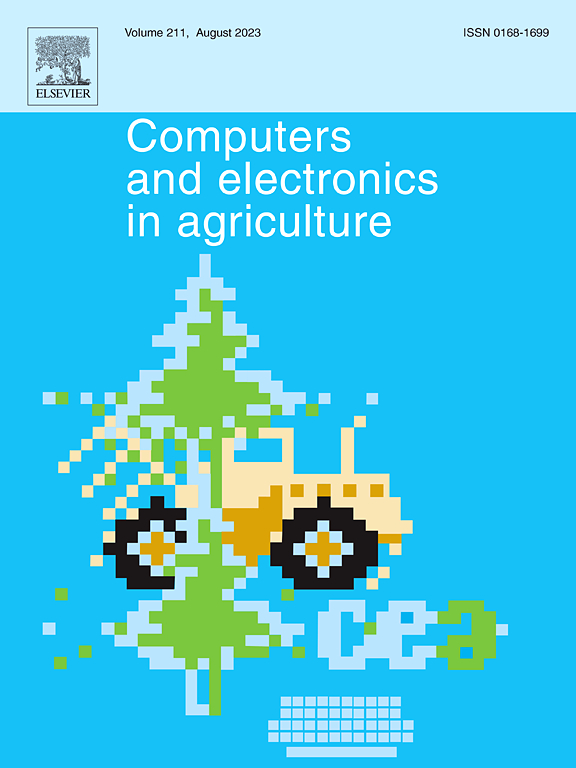An advanced structure correction spectral model using UAV multispectral images and LiDAR-based crown boundaries for estimating crown leaf nitrogen concentration in subtropical Liriodendron sino-americanum plantation
IF 8.9
1区 农林科学
Q1 AGRICULTURE, MULTIDISCIPLINARY
引用次数: 0
Abstract
Since nitrogen (N) underpins plant vitality by forming proteins, nucleic acids, and chlorophyll, quantifying it through leaf nitrogen concentration (LNC, %) becomes pivotal for growth assessment and precision forestry. However, the three-dimensional structure of the canopy, crown shadow and other background factors complicate the estimation of LNC from crown bidirectional reflectance factor (BRF). To address these challenges, we employ canopy scattering coefficients (CSC) to analyze light behavior within canopies. Accurate estimation of N relies on the association of N with chlorophyll, dry matter, water and canopy structure. To improve the LNC prediction, we developed an enhanced spectral index model called the Difference combined Simple Ratio index (DSR), which improves LNC estimation by minimizing the effects of canopy structure and shadows. Results indicate that the shadow-filtering index methods effectively eliminated shadowed pixels, enhancing the correlation between single-band reflectance and LNC. The CSC-based DSR is the best crown-level LNC estimation for Liriodendron sino-americanum plantation (R2 > 0.77, RMSE < 0.7). The estimation model exhibits significant potential for mapping crown-scale LNC distributions in Liriodendron sino-americanum plantations, as well as improving the understanding of the confounding effects of canopy structure and shadows on the LNC estimation.

基于无人机多光谱图像和激光雷达树冠边界的先进结构校正光谱模型估算亚热带中美Liriodendron人工林树冠叶片氮浓度
由于氮(N)通过形成蛋白质、核酸和叶绿素来支撑植物的活力,因此通过叶片氮浓度(LNC, %)对其进行量化成为生长评估和精准林业的关键。然而,树冠的三维结构、树冠阴影和其他背景因素使利用树冠双向反射因子(BRF)估算LNC变得复杂。为了解决这些问题,我们采用冠层散射系数(CSC)来分析冠层内的光行为。氮的准确估算依赖于氮与叶绿素、干物质、水分和冠层结构的关系。为了改善LNC的预测,我们开发了一种增强型的光谱指数模型,称为差分组合简单比指数(DSR),该模型通过最小化冠层结构和阴影的影响来改善LNC的估计。结果表明,阴影滤波指数方法有效地消除了阴影像元,增强了单波段反射率与LNC之间的相关性。基于csc的DSR是最适合中美鹅掌楸人工林的树冠水平LNC估计(R2 >;0.77, RMSE <;0.7)。该估算模型在绘制美洲鹅掌楸人工林林冠尺度LNC分布以及加深对冠层结构和阴影对LNC估算的混淆效应的理解方面具有重要的潜力。
本文章由计算机程序翻译,如有差异,请以英文原文为准。
求助全文
约1分钟内获得全文
求助全文
来源期刊

Computers and Electronics in Agriculture
工程技术-计算机:跨学科应用
CiteScore
15.30
自引率
14.50%
发文量
800
审稿时长
62 days
期刊介绍:
Computers and Electronics in Agriculture provides international coverage of advancements in computer hardware, software, electronic instrumentation, and control systems applied to agricultural challenges. Encompassing agronomy, horticulture, forestry, aquaculture, and animal farming, the journal publishes original papers, reviews, and applications notes. It explores the use of computers and electronics in plant or animal agricultural production, covering topics like agricultural soils, water, pests, controlled environments, and waste. The scope extends to on-farm post-harvest operations and relevant technologies, including artificial intelligence, sensors, machine vision, robotics, networking, and simulation modeling. Its companion journal, Smart Agricultural Technology, continues the focus on smart applications in production agriculture.
 求助内容:
求助内容: 应助结果提醒方式:
应助结果提醒方式:


